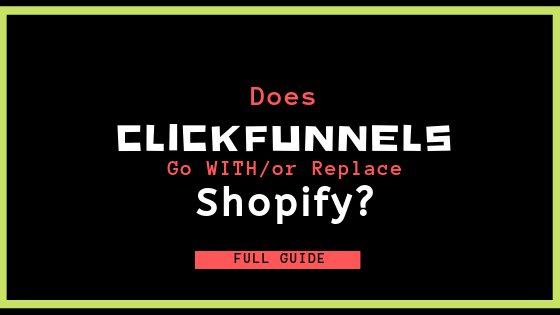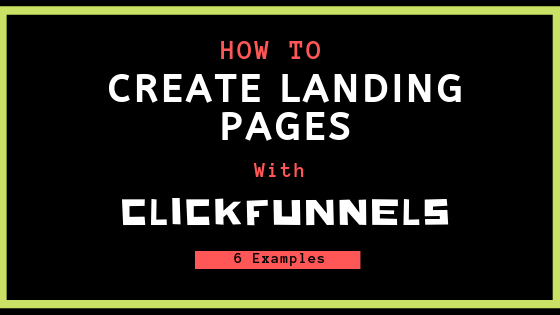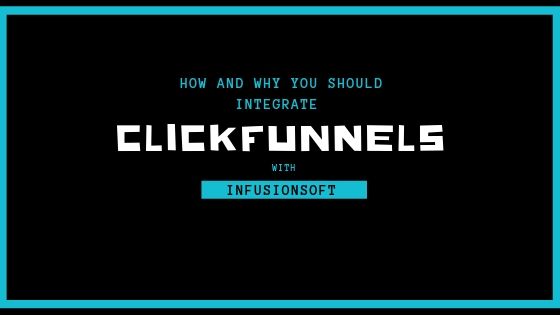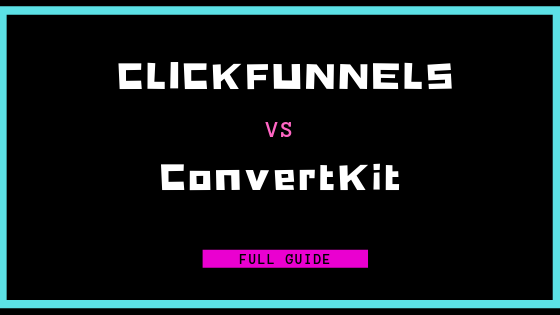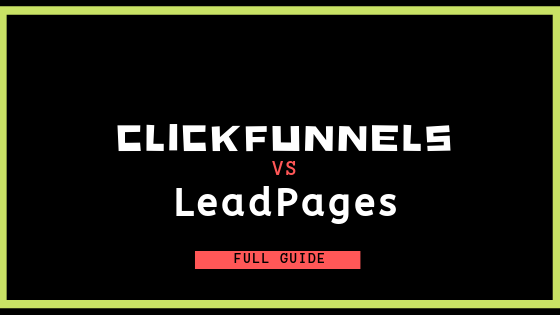Clickfunnels & Shopify: Partners NOT Alternatives
Starting your own business is easier than ever in today’s internet-driven world. Online commerce platforms like Shopify allow you to create and customize your very own online store. Different marketing options are also available online – like Clickfunnels, which is a popular sales funnel software. The question is: can these programs work together to maximize your business?
Are Clickfunnels and Shopify alternative business methods or partners in success? It is highly recommended to use Shopify and Clickfunnels together to create the best possible online environment for your sales to increase and your business to prosper.
While both Shopify and Clickfunnels can be used separately to run your online business, they result in much more success when used together.
How do Clickfunnels and Shopify Work Together?
Before you can understand how Clickfunnels and Shopify work together, you must know how they work alone. Clickfunnels focuses on expanding your business through a “sales funnel” process. Essentially, the program puts the possible customer through a series of steps designed to pique their interest in your business, have them sign up for your email list, and offer special deals to make them a repeat customer.
Shopify, on the other hand, is an entire online commerce platform. It allows you to create your own online store, sell in multiple places, and offers tools to help you grow and manage your business. The program lets you manage everything for your own business – products, inventory, payments, and shipping. You can even use your own domain name for your store to clearly link it to your website.
Clearly, both Clickfunnels and Shopify can result in a successful business alone; however, together, they can help your business expand more quickly and efficiently.
Once you’ve integrated Clickfunnels into Shopify, you will put together your store’s sales funnel. Different products and services will require different sales funnels, but it is possible to work any item or service into a successful sales funnel. Typically, a sales funnel includes three parts – a page, an offer, and an opportunity to act on a special deal.
One example of a proper sales funnel is:
- The Sales Page – The sales page is what is meant to draw a potential customer in and make them want to purchase from your store. It is the most in-depth and detailed part of your sales funnel. It is extremely important that you offer your best-selling product, item, or service on the sales page. If the potential customer doesn’t purchase it, they won’t see the rest of your sales funnel. Make sure to include the following elements on your sales page:
- A catchy headline and sub-headlines
- Product or service images, videos, and/or testimonials
- An explanation of the benefits and features of the product or service
- A “Fast Action Bonus” that encourages the customer to purchase right now to receive a special bonus. This can be a free gift with purchase, a percentage off of their next purchase, or an offer for a free item with the purchase of another specific item within a specified amount of time.
- A brief but informative “About Us” section to let the customer know why they should buy from you
- Frequently asked questions about what is being offered on the sales page and answers to them
- A “Guarantee” that you are confident your business and products/services will back up
- A final comment about why the customer should purchase this product or service and a call to action to do it now
- The 2-Step Order Form – This order form is designed to be simple, efficient, and save all customer information, so you can contact them easily in the future.
- During the first step, the customer is prompted to enter their shipping information or contact information, which includes their full name, email address, and shipping address.
- Once they have entered this information, they must click “Go to Step 2” before continuing. This order form saves all the information entered into Step 1 – allowing you to reach out to them in the future even if they do not complete their order.
- The second step asks for payment information.
- Right above the “Complete Order” option, there should be a “One-Time-Offer” that can be added to the customer’s order right then before checkout. It’s good to offer a digital product if you can because they are almost all profit for you. The one-time-offer option can increase your sale with just the click of a little checkbox.
- The Cart Abandonment Follow-Up – This step of your sales funnel involves sending emails to potential customers that abandoned their cart – choosing not to purchase while leaving all chosen items in the cart. This step can only be done if the person filled out Step 1 of the order form. Generally, two cart abandonment emails are sent out.
- Send an email 1 hour after abandonment stating that the potential customer’s cart has been reserved and is still available to be purchased. List what is in their cart and include a link that will bring them straight to their cart for purchase.
- Send another email 1 day after abandonment with the same information as the 1-hour email. However, add that this email will be the last reminder about their cart.
- The One-Time-Offer Pages – Next, your customer should be directed to a “One-Time-Offer” or OTO page immediately after their purchase. It is suggested to have two OTO pages in place that offer two different products, items, or services. However, you keep the design of both pages similar. OTO pages should include the following information:
- A top bar letting your customers know what step of the process they are on. For example, the top bar of OTO page 1 will let the customer know their purchase was completed, and the top bar of OTO page 2 will let the customer know they are on the last step.
- A catchy heading and sub-headings
- A 3-5 minute video is recommended because videos result in more OTO sales; however, you can use text and picture to describe your offer
- A list of the features and benefits of your offer – use bullets!
- A Yes button and a No button that will give their decision and move them to the next step
- The Downsell Page – This page offers a downsell to the potential customer. A downsell is usually a cheaper alternative or addition to what they’ve encountered thus far in your sales funnel. Some things normally offered on a downsell page are:
- Offer a cheaper version of the OTO they turned down.
- Offer a discount.
- Offer a bonus, like free shipping or a free gift.
- Offer a payment plan.
- Ask one last time if they are sure they don’t want to OTO product.
- The Order Confirmation Page – This is the very last step of the sales funnel. It confirms the customer’s order by listing what they bought throughout the buying (sales funnel) process. For this page, make sure to include links to other items or services that you offer.
How to Integrate Clickfunnels into Your Shopify
The sales funnel is an effective method for maximizing your sales. However, before you can start enjoying the sales funnel benefits, you must integrate Clickfunnels into your Shopify. The steps are simple to follow, and the integration is finished in no time.
The steps for integrating Clickfunnels into Shopify are:
- Make sure that you have a Shopify store account that is already set up with products to sell.
- Purchase a Clickfunnels account.
- Go into your Clickfunnels account and click on the circle image on the top right of the screen.
- Select Add New Integration.
- Search for Shopify. When it appears, select Shopify.
- Configure your Shopify integration by choosing an integration nickname and providing your Shopify store URL. Click Connect Integration.
- Verify the integration by clicking the confirmation link.
That’s it! That’s all it takes to connect Clickfunnels to your Shopify and begin growing your business faster than ever before.
The Cost and Features of Clickfunnels
Clickfunnels allows for people to expand their businesses through sales funnels. It easily combines the different aspects of the online buying process into a step-by-step method that includes various shop features like order forms, subscription options, shopping carts, and special offers all in one smooth-running system. Clickfunnels makes it easy to customize your sales process while optimizing it.
To purchase the basic Clickfunnels software, you will pay $97 per month. This option includes:
- 14-day free trial
- 20 funnels
- 100 pages
- 20,000 visitors a month
- Unlimited customers and contacts
- 3 custom domains
- Pre-made funnel templates
- A/B screening
- Online webinars
- 1 billing option integration
- 24/7 online customer service
The basic Clickfunnels package is recommended for organizations with e-mail marketing abilities that want to start using landing pages, small businesses that don’t have sales funnels, and anyone who is new to running a company online.
To purchase the Clickfunnels Etison Suite, you will pay $297 per month. This option includes:
- 14-day free trial
- Unlimited pages
- Unlimited funnels
- Limitless visitors
- Unlimited custom domains
- Email list tools
- 3 billing choices
- Top priority online customer service
- Actionetics
- Backpack affiliate program integration
The Etison Suite package is recommended for well-established organizations, companies that need more than 20 funnels, someone who wants to start an affiliate program for their business, and organizations that don’t have sales funnels. There are two very helpful features in the Etison Suite – Actionetics and Backpack Affiliate Program Integration.
Actionetics allows business owners to create their own action funnels to send emails and reveal how visitors are being directed to their site. You can also separate your consumers into groups based on what they visit on your site for more targeted email marketing.
Backpack Affiliate Program Integration lets business owners create their own affiliate programs and allows them to see their current affiliates’ sales and clicks. It’s helpful in keeping track of how much you will owe your affiliate referral partners.
The Advantages and Disadvantages of Clickfunnels
The amazing thing about software like Clickfunnels is that it allows you to automate every single stage of your business’s buying process. Sales funnels allow your business to begin growing without having to be a top-ranked website in search results. Don’t worry, though. Using this program will help to catapult your business to the top soon enough!
Some advantages of the Clickfunnels software are:
- It offers well-designed pre-made funnel templates. Clickfunnels offers different funnel templates that are already made to cater to different sales funnel needs – like gathering data or selling product bundles. With many designs and types to choose from, you are sure to find one that is perfect for your business.
- It has a very easy, step-by-step funnel editing process. When you’ve chosen your template and want to edit it, you will have access to a simple drag and drop editor to make any changes you want to make.
- The program offers sales analytics. You will have access to amazing analytical tools that will help you track the trends in your sales and see if you are making any money off of your investments. This tool is vital for being able to make strategic changes in your business and marketing that will lead to success.
- It offers many different functions for growing your business. Not only does it offer sales funnels, but you also gain access to landing pages for your products, lead generation systems, membership sites, and sales and transaction management tools. You can also create automated emails and divided test and plan events.
- The program is very easy to understand and simple to use. You will find that Clickfunnels guides you through all the different functions it offers to make sure that you understand what you are doing.
Some disadvantages of the Clickfunnels software are:
- The program is rather pricey. With the basic package being $97 a month, it is not very easy for small business owners that are just starting out to be able to afford the program. In addition, the premium Etison Suite option is $297 a month, which is very far out of many start-up companies’ price range.
- There is a learning curve involved. While Clickfunnels does guide you through all of its functions, there are still many of them to learn. It will take a while before you are proficient in what the program offers. This is not a quick-fix marketing strategy. It is a detailed guide to your success.
The Cost and Features of Shopify
Shopify is an online commerce platform that is expertly made to cater to serious entrepreneurs who are already familiar with how online selling works. Before hastily making a Shopify account, it is wise to make sure that you are knowledgeable about online marketing and marketing software, creating sales funnels that benefit your shop growth, and turning your site visitors into repeat customers.
There are three monthly plans that business owners can choose with Shopify.
| Features Included | Basic Shopify $29 per month New business | Shopify $79 per month Growing business | Advanced Shopify $299 per month Advanced business |
| Online store | Yes | Yes | Yes |
| Unlimited products | Yes | Yes | Yes |
| Staff accounts | 2 | 5 | 15 |
| 24/7 support | Yes | Yes | Yes |
| Sales channels | Yes | Yes | Yes |
| Manual order creation | Yes | Yes | Yes |
| Discount codes | Yes | Yes | Yes |
| Free SSL certificate | Yes | Yes | Yes |
| Abandoned cart recovery | Yes | Yes | Yes |
| Gift cards | Yes | Yes | |
| Professional reports | Yes | Yes | |
| Advanced report builder | Yes | ||
| 3rd party calculated shipping rates | Yes | ||
| Shipping discount | Up to 64% | Up to 72% | Up to 74% |
| Print shipping labels | Yes | Yes | Yes |
| USPS Priority Mail Cubic pricing | Yes | Yes | |
| Shopify Point of Sale App | Yes | Yes | Yes |
| Register shifts | Yes | Yes | |
| Hardware peripheral support | Yes | Yes | Yes |
| Unlimited Shopify Point of Sale staff PINs | Yes | Yes | |
| 3rd party Point of Sale Apps | Yes | Yes | Yes |
As far as receiving payments within your Shopify store, the different plans offer varying fees. However, all plans offer fraud protection. The Shopify payment fees, based on the monthly plan, are:
Basic Shopify
- Online credit card rates – 2.9% + 30 cents
- In-person credit card rates – 2.7% + 0 cents
- Additional fees when using payment methods outside of Spotify – 2%
Shopify
- Online credit card rates – 2.6% + 30 cents
- In-person credit card rates – 2.5% + 0 cents
- Additional fees when using payment methods outside of Spotify – 1%
Advanced Shopify
- Online credit card rates – 2.4% + 30 cents
- In-person credit card rates – 2.4% + 0 cents
- Additional fees when using payment methods outside of Spotify – 0.5%
Shopify is a well-developed site that offers great features to its users. The seven most notable features of Shopify are:
Online Store Builder – Shopify offers both free and paid pre-made themes for your store and drag and drop website builder that offers full customization options.
Inventory Management System – As you upload products onto your store, you assign their descriptions and insert the number of that item you have on-hand. The website offers automatic tracking of your sales to let you know when it’s time to order more of an item. You are also free to make your own restocking choices as well.
Analytics Dashboard – Shopify records your shop analytics, like your site traffic, orders, and sales, and then displays them to you in easy to understand graphs and charts. It also tells you details about your customers. This information helps you to make important decisions regarding your business.
Customer Management System – The customer management system lets you track the behavior of and save the information of the people who purchase from you. You can organize customers into groups by their preferences for email marketing purposes and even send refunds to customers with this feature.
Sales Channels – Shopify allows you to sell your items and services in multiple places while keeping all of your sales information organized within your Shopify account.
App Store – The website has an App Store that sells different add-ons and plugins that can enhance your site and make it more suitable for your needs.
Payment Integration – Shopify gives you the freedom to accept a large number of payment options. It also adds the city and state taxes of your country for you and allows you to offer free shipping to your customers.
The Advantages and Disadvantages of Shopify
It is obvious that Shopify is a great commerce platform that could bring success to any entrepreneur. It is a widely popular site that services an incredible amount of business owners throughout the world, so it has worked hard at ironing out its kinks to provide its users with a dependable and secure place to sell their goods and services. However, the platform is not without its disadvantages.
Some advantages of Shopify are:
- It already has the speed and security you need for hosting. You don’t have to worry about making sure your website is safe and running efficiently because Shopify has taken care of that for you.
- It offers everything you need to make a successful store. As you’ve read, there are many features offered that help to simplify your experience.
- Shopify has great customer support. Not only can you email, chat, or call a customer support representative and get a quick response, but there is a huge online database of FAQs that focus on Shopify issues that you can access.
- It is SEO compatible. Shopify has designed its platform around Search Engine Optimization keyword features and meta descriptions, so you can be sure that your products will be seen in online searches.
- It offers even more store customization with add-ons. You can search for add-ons that can further specialize your store for what you are selling to your customers and even find add-ons that help to make your experience more convenient.
Some disadvantages of Shopify are:
- The pricing is not great. While the monthly plans have set prices, there are hidden prices or prices that you may not understand when you sign up. For instance, the fees associated with credit card payments should be considered carefully when signing up for a plan. Some of the add-ons you may find necessary can cost you.
- The content marketing is severely lacking. While the platform does offer blogging software, it is not very good blogging software. Content marketing is necessary to grow your brand, so you may want to look into finding a blogging software that you can use alongside your Shopify store.
- The jargon is confusing. It will take some time for you to understand the way that Shopify has labeled its different categories and sections because they are not labeled like most other sites.
- Be prepared to spend a lot of time setting up your online store. The platform is very thorough and does not allow you to take shortcuts. So, when you start to add your items and details, be prepared to dedicate a good bit of time. It is not a quick process.
The Bottom Line – Why You Need Both Clickfunnels and Shopify
Many people have treated Clickfunnels and Shopify as if they are direct competitors in business building, but this is simply not true. Clickfunnels is suitable for selling a small number of products by focusing on email campaigns, product launches, and promotions. Shopify is suitable for selling a large number of products and focuses on repeat buyers and building a brand.
The truth is, however, that both Clickfunnels and Shopify have the exact same goal – driving sales and turning site visitors into paying customers. This is what makes them perfect partners.
Shopify provides a solid and secure e-commerce site that gives you unlimited product listings with unlimited bandwidth and storage. It provides access to many reports – customer, financial, marketing, search data, and abandoned carts – that allows you to see exactly how your business is faring, what items are selling the best, and keep track of your business financial information.
On the other hand, Clickfunnels brings extremely effective marketing to your Shopify store. It helps to create successful sales funnel campaigns in a matter of hours instead of days. The sales funnels that you create with the program are able to be targeted specifically to your business niche – and you hold all of the control. Additionally, Clickfunnels offers email and text integration for marketing.
The combination of these two sales options is truly a business building powerhouse. Their weaknesses and strengths balance each other out and create the perfect scenario for success.
Some tips for starting an online business using Shopify and Clickfunnels are:
- Choose the Basic Shopify option and the basic Clickfunnels package to begin. This is all you will need for a while for a start-up business.
- Set up your Shopify completely first. As stated before, it is a time-consuming process. Before you start focusing on marketing, get your store ready.
- Then, integrate Clickfunnels into your Shopify, and make your first sales funnel. Take some time to monitor these sales funnel to see what you may need to change in future sales funnels in order to make them more successful.
Once you get the hang of what is required to keep your Shopify store updated and visible in search results and learn to make effective sales funnels, you will quickly see that your time and efforts are paying off. No two separate sales platforms have ever worked as well together as Clickfunnels and Shopify.
